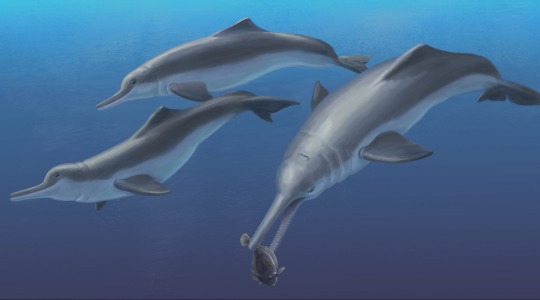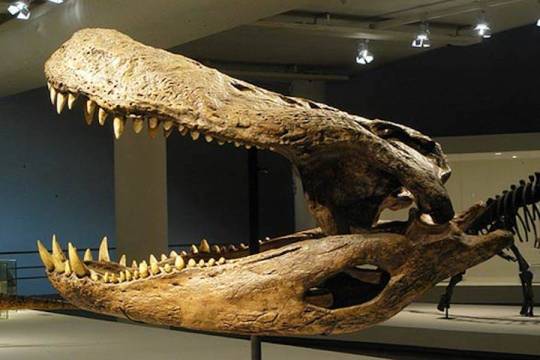#isthminia
Explore tagged Tumblr posts
Text
National Fossil: Panama
The columbian mammoths have won in Mexico!
The fossil record for many Central American countries is a bit scarce, so I‘m gonna skip over to Panama, while I think about what to do with the other countries.
Once again, you get to vote on which fossil should represent the nation. As always, it could be a fossil that is just exceptionally well preserved and beautiful, had a huge impact on paleontology and our knowledge of the past, is very common/representative of the area, is beloved and famous in the public eye, is just a very unique and interesting find, or has any other justification.
Here are your options:

Panamacebus: Our first (and very fittingly named) candidate is only known from a couple of teeth, but they are very important teeth, as they mark the oldest known instance of South American animals making it over to North America (the two continents used to be divided by sea). The capuchin like monkey lived 20 million years ago, more than 10 million years before the next known case of this migration happened


Isthminia: Named after the Isthmus of Panama the river dolphin was a relative to modern Amazon river dolphins (Art by Julia Molnar)

Purussaurus: It is a giant crocodile with size estimates upwards of 10 m, what else do I need to say? They lived during the Miocene in South America, but were also found in Panama

Mixotoxodon: Only known from fragmentary remains, but this is the only one of the South American Native Ungulates (a weird brand of ungulates not related to any of the other ones we have today) that made it into Central America once the two landmasses connected (Art by Bran-Artworks)


Scelidotherium: I have to give some ground sloth representation! This one looks almost like an ant-eater and was found in South America and also Panama (Art by Martina Chernelli)

Cuvieronius: This one is from an originally North American animal group, the gomphotheres (related to elephants). Cuvieronius was among the last of its kind only becoming extinct at the end of the Pleistocene. Their range extended all the way from the southern US through Central America and into South America
#paleontology#paleoblr#fossils#panamacebus#isthminia#purussaurus#mixotoxodon#scelidotherium#cuvieronius
4 notes
·
View notes
Text
The Beautiful “Pink River Dolphin”

The rare “Pink River Dolphin” also know as the Boto, Amazon River Dolphin, or the Inia boliviensis is truly beautiful and tragic species of dolphin
Scientific name:
Inia boliviensis
Taxonomic Classification:
Class: Mammalia
Order: Cetacea
Suborder: Odontoceti
Family: Iniidae
Genus: Inia
Species: Geoffrensis
Nutritional Requirement:
The Inia boliviensis eats Amazon catfish and other scaly fish, this includes piranhas and bottom-dwelling crustaceans.
Growth and development:
Amazon River Dolphins take about 9 to 12 months to be birthed, after birth the young dolphin nurses for up to 12 months. Amazon River Dolphins have a lifespan of up to 30 years
Behavior:
Pink River Dolphins are usually found in groups of 2 to 4 dolphins, but can also be alone. In presence of abundant prey or during a dry season Amazon River Dolphins will form groups of 10 to 15 dolphins. Inia boliviensis breath at a shallow angle, showing beak, melon, and dorsal fin at the same time, they also rarely leap from the water.
Reproduction:
Inia boliviensis breed seasonally, and most calves are born between July and September after the long birthing process.
Evolutionary Origins:
The Isthminia panamensis is the likely ancestor of the River Dolphin. A fossil of the Isthminia panamensis was found off the coast Panama in 2011 and it’s was concluded that this prehistoric dolphin is a likely ancestor to the River Dolphin
Habitat:
The Inia boliviensis live throughout much of the Amazon and Orinoco rivers basins. The pink river dolphin is found in lowland fast flowing, whitewater, clearwater, or blackwater rivers.
A Not so Fun Fact about the “The Pink Dolphin”:
Sadly the Inia boliviensis is an endangered to vulnerable species, boats, accidental fishing hazards, dam construction, and pollution all push the Amazon River Dolphin to endangerment. This is a sad fact but being educated about why species are pushed to endangerment can help us make decisions that benefit us and the animals that live with us.

My picture of the Pink River Dolphin
Sources
http://acsonline.org/fact-sheets/boto-amazon-river-dolphin/
http://www.whalefacts.org/pink-amazon-river-dolphin-facts/
http://us.whales.org/species-guide/amazon-river-dolphin
http://wwf.panda.org/what_we_do/endangered_species/cetaceans/about/river_dolphins/pink_river_dolphin/
http://www.sciencemag.org/news/2015/09/river-dolphin-s-ancestor-unearthed
Image credit:
http://www.animalspot.net/wp-content/uploads/2016/04/Amazon-River-Dolphin.jpg
2 notes
·
View notes
Link
The skull and jaws of Isthminia panamensis (USNM546125) carefully posed in near-life articulation by NMNH Imaging. (Photo NMNH Imaging / Smithsonian Institution) Careful readers of this blog probably recognize this skull and jaws, but perhaps not the name that goes with them. Finally, after four years of hard work, my colleagues and I are happy to announce the newest fossil cetacean, Isthminia panamensis, published today in PeerJ (open-access and online). This fossil was originally found in , an...
0 notes